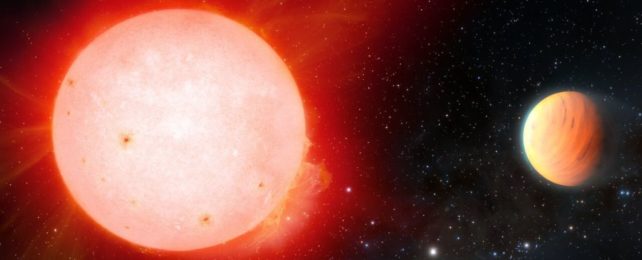If exoplanet research is to be believed, the Milky Way galaxy could be like some sort of fantastical candy-land.
First, there was the discovery of exoplanets with the density of cotton candy. Now, astronomers say they've discovered a world that is comparable to the density of marshmallow. It is, they say, the fluffiest exoplanet discovered to date orbiting a red dwarf star.
This is important. It means that worlds with significant gas envelopes can be found closely orbiting the small, tempestuous dwarf stars, which astronomers had previously suspected might strip any closely orbiting planets of a large proportion of their atmospheres.
Since atmospheres are thought to be one of the key planetary characteristics that allow life to form and thrive, this would have implications for our understanding of the habitability of planets orbiting red dwarf stars.
"Giant planets around red dwarf stars have traditionally been thought to be hard to form," says planetary astronomer Shubham Kanodia of Carnegie Institution for Science's Earth and Planets Laboratory.
"So far this has only been looked at with small samples from Doppler surveys, which typically have found giant planets further away from these red dwarf stars. Until now we have not had a large enough sample of planets to find close-in gas planets in a robust manner."
Red dwarf stars are, by far, the most numerous stars in the Milky Way. They're very small and cool and dim – so dim, in fact, that not a single one can be seen with the naked eye, in spite of making up around 73 percent of all stars in the Milky Way.
Because they are small, they burn more slowly and way less hot than stars like our Sun, which means they have significantly longer lifespans. Our Sun's lifespan is estimated to be about 10 billion years. Red dwarf stars are expected to live trillions of years. This longevity, coupled with the abundance of red dwarf stars, means that life, if it's going to emerge somewhere, might emerge on a planet orbiting a red dwarf star.
But red dwarfs can be really, really cranky, too, lashing the space around them with powerful flares that could irradiate and sterilize any exoplanets in close orbit, and strip them of their atmospheres. And because these stars are so cool, in order for an exoplanet to have a temperature conducive to life as we know it, that planet would need to be within flare-lashing range. So, you know, that's a problem.
But maybe it isn't, as this new world suggests. It's called TOI-3757b, and it's a gas giant orbiting a red dwarf star in the constellation of Auriga, about 580 light-years away.
TOI-3757b was detected using the TESS space telescope, which finds exoplanets by detecting the regular dips in light caused by the planet passing in front of the star. If you know how bright the star is, how much light is blocked tells you how big the exoplanet is. From this, we know TOI-3757b is a little bigger than Jupiter.
Then, to obtain the mass of the exoplanet, the researchers looked for changes in the star's light that show the gravitational pull on it exerted by the exoplanet. Since gravity is related to mass, this gave us a mass of about 85 Earths.
Jupiter, by context, is around 318 Earths in mass, with an average density of 1.33 grams per cubic centimeter. The average density of TOI-3757b is 0.27 grams per cubic centimeter. That's one extremely fluffy exoplanet – so fluffy that it's unclear how it could have formed so close to its star: it completes one orbit every 3.43 days.
Kanodia and his colleagues think that there could be two factors at play. Firstly, gas giants form with a rocky core, around which gas accumulates to form a thick, extended atmosphere. Because the red dwarf star is low in heavy elements compared to other red dwarfs with gas giants, perhaps the rocky core formed a bit more slowly, which would have delayed gas accumulation and affected the density of the world.
Secondly, the orbit seems to be slightly oval, which means its distance from the star varies. Perhaps when it draws closer, the atmosphere heats up and expands.
Other astronomers have suggested that puffy exoplanets might have extended ring systems, like Saturn; but Kanodia and the other researchers found that TOI-3757b is simply too close to its star to maintain a stable ring system. So it probably is just a really puffy atmosphere.
The team hopes to find and study other such marshmallow worlds out there, to help figure out how they form and survive in a place where it ought to be difficult for them to do so.
"Finding more such systems with giant planets – which were once theorized to be extremely rare around red dwarfs – is part of our goal to understand how planets form," Kanodia says.
We hope they're sufficiently equipped with sugary snacks.
The team's research has been published in The Astronomical Journal.
